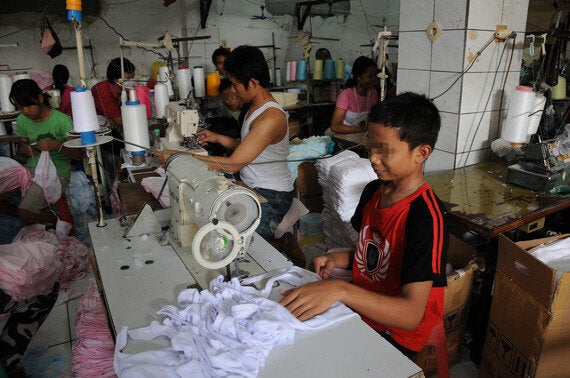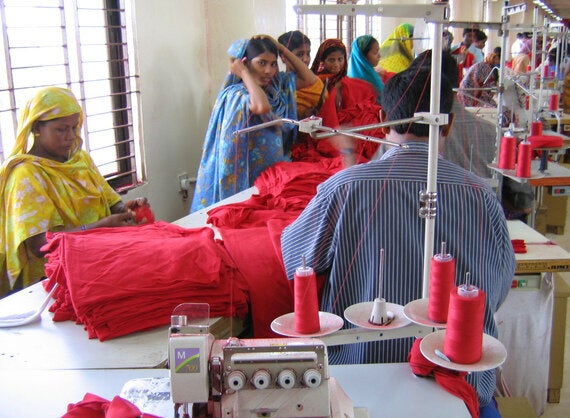This blog is part of a month-long focus around sustainable fashion across HuffPost UK Style and Lifestyle. Here we aim to champion some of the emerging names in fashion and shine a light on the truth about the impact our appetite for fast fashion has around the world.
Consumers across the globe care about whether their clothes are ethically produced, and they want to be able to make purchases that match their values. According to a recent Nielsen report, 55% of consumers surveyed across 60 countries want to buy brands that are committed to social and environmental responsibility, and the "sustainability mainstream" is increasing.
Yet, most likely, the clothes you're wearing come from a sweatshop. While a few brands like Patagonia have truly committed to ethical sourcing, today's apparel supply chains are largely no better than they were in the 90's, when sweatshop exposés triggered a wave of outrage among consumers. In fact, modern supply chains are even more gnarled and opaque, and rife with human rights abuse. Most clothing products are still produced in horrendous and life-threatening conditions, and by exploited labourers who are often trafficked workers or children.

Image: A still from the documentary, The True Cost; Credit: The True Cost
Fashion is also one of the worst offenders when it comes to pollution - textiles are the second greatest contributor to global water pollution, according to the World Bank. And the apparel industry is only second to oil when it comes to environmental impact as a whole, according a 2013 report by the Danish Fashion Institute. Synthetic fibres like polyester are derived from petrochemicals, and natural fibres like rayon and viscose are contributing to the destruction of ancient rainforests.
The problems are manifold and well-documented by the industry. Yet, brands - including companies committed to sustainability, like Patagonia - still struggle to have full control over every step of the garment manufacturing process. And, everyday people remain largely unaware of the trail of harm that led to the creation of their clothes.
"The label in a garment may tell us where it was produced, but it doesn't tell us whether it was made from child-picked cotton in Uzbekistan, spun by bonded labourers in India, dyed using hazardous chemicals in China, or cut and sewn in an unregistered factory in Bangladesh," according to an annual report by C&A Foundation.

The International Labour Organisation (ILO) estimates that 11 percent of the world's children are engaged in child labour, with many employed in garment manufacturing. Image: Child workers at a small garment factory in Jakarta, Indonesia; Credit: ILO in Asia and the Pacific
But could there be silver lining under fashion's dirty garments? Absolutely. An array of solutions - including improved laws and enforcement, revamped traceability processes, and a true commitment to sustainability - are being unlocked by a handful of forward-thinking brands, initiatives like the Accord on Fire and Building Safety in Bangladesh, and non-profits like Canopy and Verité. Campaigns like Fashion Revolution Day and a new documentary film, The True Cost, are engaging consumers and renewing the call for change.
Moreover, social entrepreneurs are driving fresh approaches that could help the apparel industry truly clean up its act and achieve both style and substance. From the toolbox of social entrepreneurs, here are three more reasons to be optimistic about the future of fashion:
1. More industries can get involved to end human trafficking in fashion
Fashion's extraordinarily complex global supply chains might make change seem daunting, but perhaps that's because the industry has largely looked to itself for solutions. What if more players - like finance, transportation, health, and agricultural R&D - got involved? Through activating a network of industries, solving sustainability issues in fashion could potentially be accomplished more effectively and with fewer resources.
For example, Truckers Against Trafficking trains everyone in the trucking industry - from trucking students to shipping partners - to become active opponents of trafficking and to learn how to spot and support victims. The organization works with law enforcement and uses existing infrastructure to combat modern slavery in sweatshops (in addition to other contexts). Another organization, Finance Alliance for Sustainable Trade, matches lenders committed to environmental sustainability with agricultural producers that share the same values. Ethical producers, such as organic cotton farmers, can thus access financial services and become more economically viable.

Image: Inside a garment factory in Bangladesh; Credit: jankie
2. Workers can be empowered to make supply chain traceability a reality
Modern supply chains involve multiple tiers of contractors, and brands that care about sustainability often only have full transparency with tier-one suppliers. When it comes to the fourth or fifth tiers, it can be next to impossible to track labour conditions. LaborVoices, however, is tackling this challenge by enabling workers to send real-time data on working conditions through their mobile phones. Available in 50 countries, the system also helps workers access information on their rights and how to resolve workplace grievances.
LaborVoices' founder, Kohl Gill, sees the industry's lack of on-the-ground information as a key hurdle to change on multiple fronts. According to Gill, "If you don't know what the labour conditions are, then you can't make proper trade policy decisions. You can't navigate your way to a good job, as a worker. You can't choose a great supplier, as a buyer. And even as a high road supplier, you can't really differentiate yourself against your competition."
LaborVoices plans to expand its services so that workers can self-report and access information on factory conditions and wages, and become empowered to make choices about their employment - "like a TripAdvisor for workers," says Gill. LaborVoices is also moving toward a subscription model for brands, so that companies no longer need to commission a specific investigation, but can simply pay to access real time information about a spread of factories. This model is scaling up this year in Bangladesh, Cambodia, and China.

Image: A still from Canopy's Fashion Loved by Forest campaign; Credit: Canopy/Grewal
3. Other pressure points, besides consumers, can disrupt business as usual
When it comes to buying ethical clothing, consumers have limited options. (Try doing a search for verifiably sustainable brands, and only a few widely recognizable names crop up.) And without the ability to access sustainability information and to make ethical point-of-sale decisions, consumers have a limited power (at the moment) to cast an economic vote for change.
But there's more than one way to incentivize (and pressure) brands to be proactive about social and economic responsibility. The citizen advocacy organization, PODER, for example, builds relationships with prominent investors and helps communities make a business case to them for sustainability. Investors can then raise their voices to calls for better working conditions and monitoring programs. "Investors stand to lose a lot of the brand price falls," says Ben Cokelet, founder of PODER and an Ashoka Fellow. "We get them to join us in encouraging brands to come to the table."
Another organization, Canopy, targets highly influential brands and designers who can then "institutionalize sustainable purchasing decisions" across the industry. Founded by Ashoka Fellow Nicole Rycroft, the organization has signed up big names in fashion like Stella McCartney, Eileen Fischer, Marks & Spencer, and Levi's to commit to eliminating rainforest deforestation from their supply chains.
"The top ten viscose producers in the world control 80% of global production," Rycroft explains. "It's a very concentrated supply chain, and it gave us a very neat place to basically create a tipping point." In the past year, by working with influential brands to develop forest-friendly policies, Canopy has been able to shift the top three viscose producers - representing 50 percent of the global supply of viscose - away from sourcing fibre from endangered forests.
This post was written by Kristie Wang for Ashoka Changemakers and Fabric of Change, a challenge in search of solutions for building a fair and sustainable apparel industry.
HuffPost UK Lifestyle is running a special series around Sustainable Fashion for the month of September. Livia Firth is creative director of Eco-Age and founder of The Green Carpet Challenge, and will be guest editing on 18 September. If you'd like to blog or get involved, please email us.